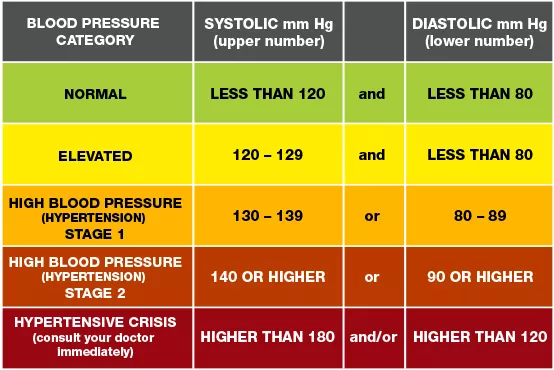Blood pressure is a crucial indicator of cardiovascular health, reflecting the force exerted by circulating blood on the walls of the arteries. It is measured using two numbers: systolic pressure (the top number) and diastolic pressure (the bottom number). Systolic pressure represents the force when the heart beats, while diastolic pressure reflects the force when the heart rests between beats. Understanding what constitutes normal systolic blood pressure (SBP) at different ages is essential for maintaining optimal health and preventing hypertension-related complications.
Understanding Blood Pressure Readings
Blood pressure readings are expressed in millimeters of mercury (mmHg). A typical reading might look like 120/80 mmHg, where 120 represents the systolic pressure and 80 represents the diastolic pressure.
The American Heart Association (AHA) categorizes blood pressure readings as follows:
- Normal: Less than 120/80 mmHg
- Elevated: 120-129/<80 mmHg
- Hypertension Stage 1: 130-139/80-89 mmHg
- Hypertension Stage 2: ≥140/≥90 mmHg
- Hypertensive Crisis: ≥180/≥120 mmHg
Factors Affecting Systolic Blood Pressure by Age
Systolic blood pressure tends to increase with age due to various physiological changes. Factors influencing these changes include:
Arterial Stiffness: With aging, arteries lose elasticity, causing an increase in systolic pressure.
Lifestyle Factors: Diet, physical activity, stress levels, and body weight significantly impact blood pressure.
Genetics: Family history plays a role in an individual’s blood pressure levels.
Medical Conditions: Conditions like diabetes, kidney disease, and hyperlipidemia can influence blood pressure.
See Also: pregnancy induced hypertension symptoms
What Is Normal Systolic Blood Pressure by Age
1. Infants and Children:
For infants and children, blood pressure norms differ significantly from adults due to the smaller size of their cardiovascular systems.
- Infants (0-1 year): 70-90 mmHg
- Toddlers (1-3 years): 80-100 mmHg
- Preschoolers (3-5 years): 80-110 mmHg
- School-aged Children (6-9 years): 85-115 mmHg
- Preteens (10-12 years): 90-120 mmHg
See Also: what does high blood pressure do to your eyes
2. Adolescents:
Adolescents experience growth spurts and hormonal changes that can affect blood pressure.
Teens (13-18 years): 95-135 mmHg
3. Adults:
Normal systolic blood pressure values for adults are generally stable but can vary slightly based on lifestyle and overall health.
Young Adults (19-40 years): 90-120 mmHg
Middle-aged Adults (41-60 years): 100-130 mmHg
4. Seniors:
For older adults, systolic blood pressure tends to increase due to arterial stiffness and other age-related changes.
Older Adults (61+ years): 110-140 mmHg
Blood Pressure Management Strategies
Maintaining normal systolic blood pressure is crucial for preventing cardiovascular diseases, stroke, and other health complications. Here are some strategies to manage and maintain healthy blood pressure levels across different age groups:
1. Healthy Diet:
A balanced diet rich in fruits, vegetables, whole grains, lean proteins, and low-fat dairy products helps regulate blood pressure. Limiting sodium intake to less than 2,300 mg per day (or 1,500 mg for those with hypertension) is particularly beneficial.
2. Regular Physical Activity:
Engaging in at least 150 minutes of moderate-intensity aerobic exercise or 75 minutes of vigorous-intensity exercise per week can help maintain normal blood pressure levels. Activities such as walking, swimming, cycling, and strength training are effective.
3. Weight Management:
Maintaining a healthy weight is essential for blood pressure control. Even a small amount of weight loss (5-10% of body weight) can significantly reduce blood pressure in overweight individuals.
4. Stress Reduction:
Chronic stress can contribute to hypertension. Techniques such as deep breathing, meditation, yoga, and mindfulness can help manage stress and lower blood pressure.
5. Limiting Alcohol and Tobacco Use:
Excessive alcohol consumption and smoking are significant risk factors for hypertension. Limiting alcohol intake to no more than one drink per day for women and two drinks per day for men, and avoiding tobacco use, are critical for maintaining healthy blood pressure.
6. Regular Monitoring:
Regular blood pressure monitoring helps detect changes early and allows for timely interventions. Home blood pressure monitors can be useful tools for individuals to track their blood pressure between medical visits.
Conclusion
Understanding normal systolic blood pressure by age is fundamental for promoting cardiovascular health and preventing hypertension-related complications. While the values can vary across different age groups, maintaining a healthy lifestyle, managing stress, and regular monitoring are key strategies for keeping blood pressure within the normal range.
By taking proactive steps, individuals can ensure better heart health and overall well-being.


